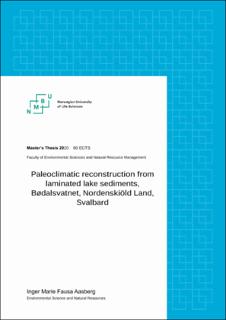| dc.contributor.advisor | Henriksen, Mona | |
| dc.contributor.advisor | Retelle, Michael | |
| dc.contributor.author | Aasberg, Inger Marie Fausa | |
| dc.coverage.spatial | Norway, Svalbard, Nordenskiöld Land | en_US |
| dc.date.accessioned | 2021-01-26T15:11:30Z | |
| dc.date.available | 2021-01-26T15:11:30Z | |
| dc.date.issued | 2020 | |
| dc.identifier.uri | https://hdl.handle.net/11250/2724833 | |
| dc.description | This thesis was conducted in connection with the University Centre in Svalbard: UNIS | en_US |
| dc.description.abstract | One predicted consequence of the current warming in the Arctic is an increase of heavy precipitation events. Svalbard have experienced an increase in total annual precipitation and air temperature have affected Svalbard’s environment, in particular the regional hydroclimate. The varved proglacial sediment record preserved in Bødalsvatnet, Nordenskiöld Land, Svalbard, contains a valuable climate signal that in this study is used to reconstruct changes in precipitation and temperature the last 150 years. The thesis uses a multi-proxy approach with varve count, physical parameters (grain size, magnetic susceptibility, dry bulk density, loss-onignition and water content) and geochemical analysis through X-ray fluorescence (K, Ca, Mn, Fe, Ti and Zr) of surface core BSV – 2019 – 1. Age determination of the surface core were cross corelated with a 2012 by varve count and plutonium (239+240Pu) measurement.
Six turbidites (E1 – E6) were identified and dated to 1936, 1945, 1957, 1983 and 1993. The six turbidites relating to mass movement events lead on by intense precipitation thought to have exceeded the 2,5 mm per hour. The current threshold for the formation of mass moment events in Svalbard. The presence of a dropstone > 1 mm within deposits from the 1957 event was likely caused by an avalanche. The 1993 and 1983 events were likely triggered by high intensity warm rainstorms related to south westerly cyclones in November and March, respectively. The mass movement event of 1974 is connected to an intense heavy precipitation event where 34 mm of rain fell during a period of 12 hours.
By cross-correlation to a longer - percussion core from 2012 the paleoclimatic record was extended to approximately 1844. The change in temperature and precipitation in combination with thicker lamina during the end of LIA has similarities to the current sedimentary record and needs to be investigated further. | en_US |
| dc.description.abstract | En forventet konsekvens av dagens oppvarming i Arktis er flere hendelser med intens nedbør. På Svalbard er har det vært en økning i total årlig nedbør og temperatur som har påvirket miljøet og da særlig hydroklimaet. Den proglasiale, årlige laminerte sedimenthistorien er bevart i Bødalsvatnet, Nordenskiöld Land, Svalbard. Den inneholder et viktig klimasignal som denne studien har brukt for å rekonstruere forandringer i nedbør og temperatur de siste 150 år. Denne oppgaven bruker en multi-proxy metode på overflatekjernen BVS-2019-1 basert på fysiske parametere (kornstørrelse, magnetisk susceptibilitet, tetthet, glødetap og vanninnhold) og kjemiske parameter ved røntgen-fluorescens (K, Ca, Mn, Fe, Ti og Zr). Aldersbestemmelse av sedimentkjernen er gjort ved å korrelere varv-telling fra 2019 med varv-telling og plutonium ( 239+240Pu) målinger fra et sediment kjerne tatt i 2012.
Seks turbiditeter (E1 til E6) er identifisert og datert til 1936, 1945, 1957, 1974, 1981 og 1993. Turbiditetene er relatert til massebevegelseshendelser forårsaket av nedbør med en intensitet over 2,5 mm i timen, som er grenseverdi for massebevegelseshendelser på Svalbard. Forekomst av droppstein > 1mm er knyttet til hendelse i 1974, forårsaket av et snøskred. Hendelsene i 1983 og 1993 er knyttet til sør-vestlig sykloner som har ført til mild regnstorm med høy intensitet i henholdsvis mars og november. Hendelsen i 1974 er knyttet til intenst regnvær hvor det falt 34 mm regn over en periode på 12 timer.
Ved å korrelere den lengre sediment kjernen fra 2012 ble den paleoklimatiske historien utvidet ytterligere, til ca. 1844. Forandringen i temperatur og nedbør sammen med tykkere lamina ved utgangen av LIA har likheter ved det nåværende sedimentære historien og trenger å bli studert ytterligere. | en_US |
| dc.language.iso | eng | en_US |
| dc.publisher | Norwegian University of Life Sciences, Ås | en_US |
| dc.rights | Attribution-NonCommercial-NoDerivatives 4.0 Internasjonal | * |
| dc.rights.uri | http://creativecommons.org/licenses/by-nc-nd/4.0/deed.no | * |
| dc.title | Paleoclimatic reconstruction from laminated lake sediments, Bødalsvatnet, Nordenskiöld Land, Svalbard | en_US |
| dc.type | Master thesis | en_US |
| dc.source.pagenumber | 117 | en_US |
| dc.description.localcode | M-MINA | en_US |

